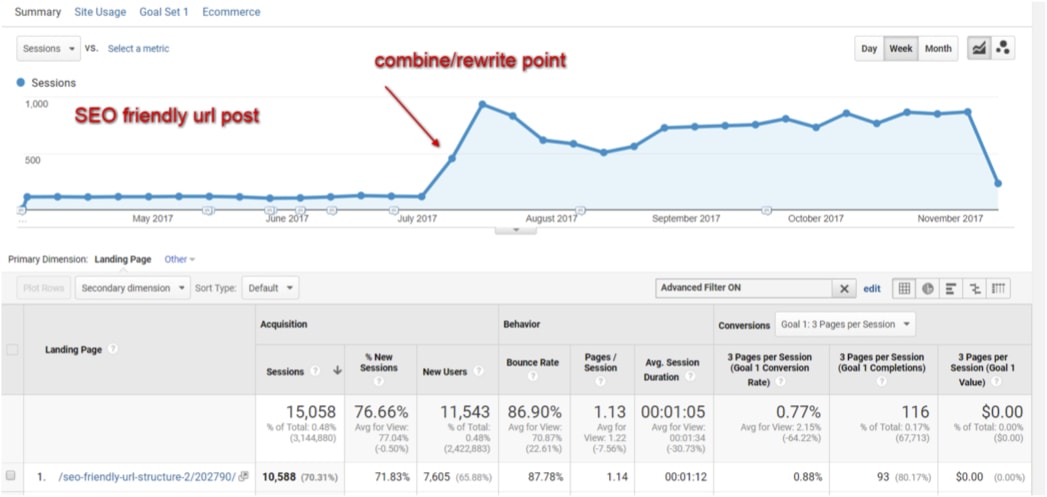Fresh content still is powerful currency when it comes to search.
Ever since Google’s Freshness update, the more recent and relevant your content is, the higher its chances to rank in SERPs.
But what about the “appearance” of freshness?
What happens when a website tweaks old content a bit and changes the date on an article from 2014 to today?
What are the SEO benefits – and the consequences?
Most importantly, how do you keep “evergreen content” – content that’s meant to withstand the test of time – current and relevant year after year?
In this article, I’ll answer these questions by examining how key influencers in the SEO and digital marketing industry treat date stamps.
I’ll also discuss my strategy for combating outdated content.
Why Change Article Dates?
Let’s start at the beginning.
First off, as explained by Google’s Martin Splitt, it’s preferable to update an old page, rather than create a new one with very similar content.
But going beyond webpage updates, date manipulation can be quite an effective way to attract some attention on the SERP.
Easiest example: somebody is searching around for keyword research guides.
They come across this kind of SERP.

Obviously the keyword research guides listed here weren’t actually originally posted in 2020.
However, since keyword research is very dependent on the freshest information available, a user will naturally gravitate towards the most current results.
This means that the benefit of updating your content regularly is two-fold.
First, it appeals to users, because we naturally want to read the most current and up-to-date information.
This means date updates increase CTR, one of the essential SEO metrics.
Second, depending on the competitive vertical, the search engine itself might understand that being current is paramount.
Then the page that hasn’t been updated since 2015 still, simply, does not get into a SERP.
Of course, the very fact that the displayed dates can be so easily changed makes a webmaster wonder if this might somehow damage their trustworthiness.
Will Changing Article Dates Impact Your SEO Negatively?
When we’re talking about changing dates, we need to be conscious of two specific types for date update:
- Changing the dates on the page itself.
- Changing the date in the sitemap.
A recent comment from John Mueller seems to indicate that even a massive date update for individual pages won’t negatively affect SEO efforts.
Regarding the sitemaps, however, Google’s sitemap guide states that a page’s <lastmod> value has to be represented accurately.
Otherwise, Google will simply stop reading it.
Furthermore, according to ShoutMeLoud’s recently updated study, the best practice for article dates is to show both the “original published” and “last updated” dates.
If you let the search engines crawl the publishing dates of your webpages, you will almost inevitably lose out in rankings.
But if you want to save your rankings, you need to show them specifically to your users.
To sum it up: if we’re talking about a publishing date that ends up on your actual page, then it’s better to hide those from the search engines.
But show users both the date of original publication and the latest update.
And in your sitemap, you should always flag the changes to primary content to avoid penalization.
How Do You Safely Keep Your Content Fresh?
Keeping your content fresh has little to do with the date on your article, at least as far as Google’s concerned.
There are many factors that affect freshness, including the:
- Frequency of your updates.
- The amount of content changed.
- Rate of new link growth.
The date an article is published is only one of these factors.
In other words, what really matters is the quality additions you’ve made to an existing page.
There are three main strategies for breathing fresh life into your old content, and all of them hinge on one simple principle:
Your content needs to be timeless, relevant, and valuable.
1. Use the Same URL But Refresh the Date
The most common strategy you’ll see is to add even more value to posts that were proven to be top performers.
Typically you do this either by supplementing the article’s original publication date with a “last updated” date stamp or an updated date beneath it.
Search Engine Journal uses this strategy, so I reached out to Danny Goodwin, SEJ’s Executive Editor, to learn what makes this strategy so effective:
“Search Engine Journal has been around since 2003 and published thousands of posts through the years.
In an industry that moves as quickly as SEO and digital marketing, information can quickly become outdated – sometimes in as little as a year or sometimes even a few months.
Outdated information is bad for users – which will reflect back on you as a brand/business. If you have a post ranking #1 that was written in 2013, it makes perfect sense to update it.
Like cars, content typically loses value as time goes by. Traffic declines.
And if you’re ranking well, those rankings tend to go away as fresher and more up to date (or more thorough) content is published by your competitors.
Here’s one example.
When I was editing for Search Engine Watch, we had a popular post, How to Use HTML Meta Tags.
I believe it was originally written in 2005 (if not earlier), ranked number one at the time, and typically drove more than 1,000 pageviews to the site every day.
But by 2012, it needed a refresh. SEO had changed quite a bit in those many years.
We kept the title, URL, and changed everything else.
After republishing (maintaining the same URL), it maintained its top spot and in fact surged for a while.
Here’s another example.
Over the years, SEJ had published probably 4-5 posts about optimizing your URL structure.
None of them were driving much traffic, and all of them had been published at least five years ago.
So one of our authors rewrote it, turning it into a comprehensive post on the topic, The Ultimate Guide for an SEO-Friendly URL Structure.
After publishing, our developer 301 redirected all the old/outdated posts to the new post.
The final result: Traffic increased by 8x!
While all these posts existed before, we updated them.That included the publication date.
I would never recommend just changing dates for the heck of it – you need to make some significant changes.
Also, with Google showing dates posts were published in the SERPs, I can pretty much guarantee you that will impact which post searchers will click on.
If I have the choice of reading content published in 2017 that ranks #3 or something published in 2011 that ranks #1, I often find myself clicking on the newer result.
Most of us humans are biased toward the ‘new.’”
Remember also to follow John Mueller’s advice: you don’t have to write that the article’s been updated every time you adjust every little thing, and it won’t affect your SEO even for the regularly updated articles.
2. Add Live Updates to a Single Page
Another strategy that’s been gaining steam in recent years is to publish news as it happens, by updating a single page with live coverage.
On these pages, you’ll typically time stamp each new entry as you post them.
For example, check out how a news agency covers urgent developments, like spreading wildfires.

Live-updating a single page and time-stamping each new addition to the page is also one of the methods Illyes recommended to Slegg.
This is in addition to adding an updated date to old articles:
“I know that especially the news team is working with lots of news publishers, for example, the BBC, on trying to figure out how to put content online that is better for the users, and BBC has these very interesting live coverage pages and basically they just the time stamp every single addition to the page – that works too.”
3. Create New Pages From Scratch & Use Redirects
Say you have three outdated pages, and all of them could be put together to fully cover one topic.
Those pages might even be performing well, so you don’t necessarily want to get rid of the juice they’re giving you.
What you might want to do then is to create a single page combining the information from the three pages.
Thoroughly researched and updated, forming one single “ultimate” page covering your topic from all angles.
You then use redirects so that people clicking on your well-performing outdated pages would instead go to your new and improved all-in-one page.
Don’t forgive to provide your new page the social media support, and include it into your link building campaigns.
Conclusion
My own preference is not to change article dates. But naturally, the path you choose is up to you.
No matter which strategy you choose, you need to remember that not every article is worth updating.
The best types of content to breathe more life into are those that are evergreen – content that is just as relevant now as it was when you first published it.
The content should also be detailed enough to have resonated with your audience when it was first published.
And there should be enough new, helpful information about that topic to add new value without derailing your original article’s subject.
Lastly, just as you would with any other new article, don’t forget to encourage new social shares.
Use social media to tell your users that you’ve updated your content, and actively engage with them through social media and your comments section to keep them interested in your update.
That’s the best way to ensure your content stays fresh.
More Resources:
- Why Content Is Important for SEO
- How to Update Sitemaps After You Change Your Content
- The Complete Guide to On-Page SEO
Image Credits
Featured image: Created by author, September 2020
Screenshots taken by author, September 2020






![AI Overviews: We Reverse-Engineered Them So You Don't Have To [+ What You Need To Do Next]](https://www.searchenginejournal.com/wp-content/uploads/2025/04/sidebar1x-455.png)